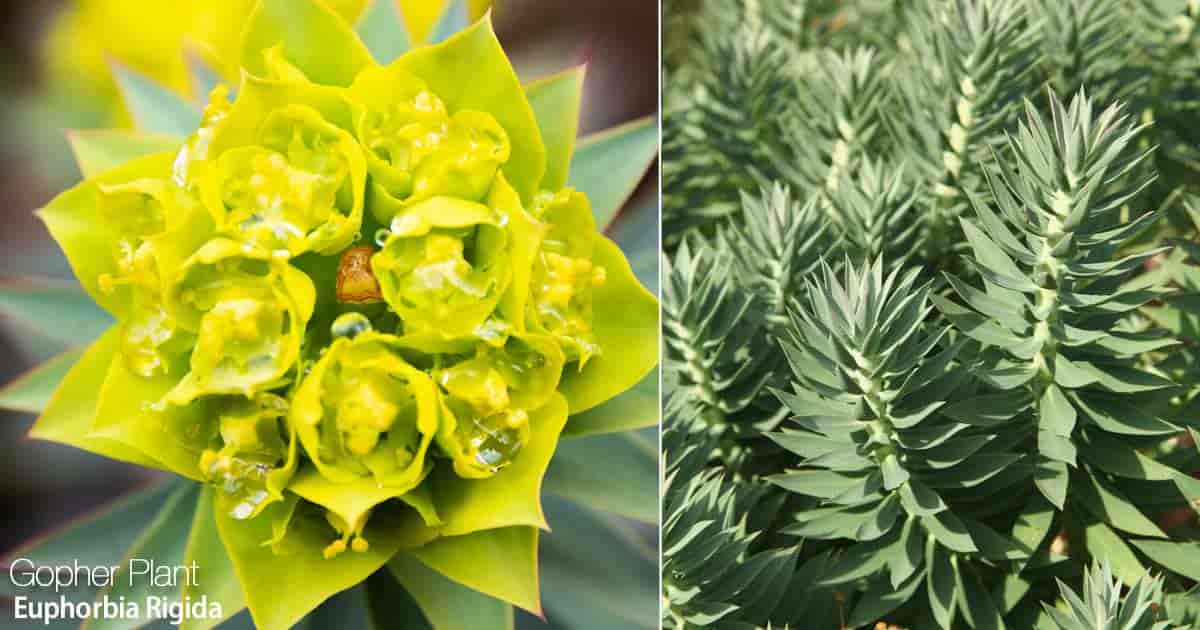Commonly known as the gopher plant, Euphorbia rigida (yew-FORB-ee-ah RIJ-id-ah) formerly known as Euphorbia biglandulosa is a perennial succulent.
Other common names include:
- Silver spurge
- Upright Myrtle Spurge
- Gopher Spurge
The silver spurge shrub is a member of the family Euphorbiaceae and one of the many types of Euphorbia plants for the landscape.

It belongs to the Euphorbia genus, named after Euphorbus, a Greek physician who is credited for introducing the Euphorbian plants.
Native to the Mediterranean and Middle East regions, the gopher plant is a low-maintenance plant-type and a drought-resistant evergreen.
Due to its unique foliage and interesting characteristics, the plant has the Royal Horticultural Society’s Award of Garden Merit to its name.
However, it is interesting to know that in its native regions, this plant is generally classified as a weed and recommended for USDA zones 7 – 10.
The good news is that, even in its natural habitat, the gopher euphorbia is not considered to be noxious or classified as a harmful or injurious weed.
Euphorbia Rigida Gopher Plant Care
Size & Growth
The gopher spurge is an easy to grow bushy perennial that grows up to be around 1′ -2′ feet tall and 2′ -3′ feet wide.
Like most other succulents, this plant has somewhat fleshy foliage that is arranged in a spiral on upright stems.
Flower Color and Fragrance
Silver spurge is a flowering plant that bears unique, showy chartreuse-yellow bracts at the branch tips that eventually develop a hint of reddish tan.
The flowers appear in dome-shaped clusters at the tips of the branches.
The flowering season for gopher spurge plants starts in late winter, ending in early spring. However, keep in mind some plants may bloom only during late spring.
Light & Temperature
Native to the Mediterranean region, these plants enjoy the full sun but do well in partial shade.
Silver spurge gopher plants are suitable for summer-dry climates. They are hardy and can survive hot weather, as well as, the colder months of the year.
It is cold tolerant to 0° degrees Fahrenheit.
Watering and Feeding
Rigida euphorbias are generally a low-maintenance drought-tolerant plant.
In fact, once established, these plants are self-sufficient.
Water only when the soil is dry for the first few inches.
The trick is to water deeply while making sure the plant is not left sitting in wet soil causing the roots to rot.
More Euphorbia plants die due to over-pampering and overwatering than neglect.
While Euphorbia rigida grows and blooms well in poor soil, you can add fertilizer or some organic matter.
When grown in containers, apply a half-strength fertilizer once a month.
Soil & Transplanting
These plants are not particular about the type of soil. In fact, they do well in poor soil out in full sun.
Gopher plants are not picky about the pH level as well.
The only soil condition required is that the soil should be well drained.
Grooming and Maintenance
Under the right conditions, these plants are generally sturdy, require little pampering and are quite self-sufficient.
How To Propagate Rigida Euphorbia Plants
Rigida plants are known to self-seed. However, to propagate from seeds, the best time to sow gopher plant seeds is during spring.
On the other hand, when propagating these plants by cuttings, use a rooting hormone and a well-draining cactus soil.
Stick the succulent plant cutting into a pot of cactus potting soil or equals parts perlite, sand, and peat moss.
Keep the soil moist (not wet). Roots should appear in about 3 weeks.
The best time for division is late spring.
Gopher Plant Pest or Disease Problems
These plants like most euphorbias are susceptible to spider mites, aphids, nematodes, and mealybugs along with bacterial and fungal diseases.
In most cases, root rot due to overwatering is what ultimately kill these plants.
Read our article for details on: Controlling Succulent Pests
Suggested Uses For The Gopher Euphorbia Plant
Euphorbia rigida is an ornamental that can add to the beauty of any garden.
Plant in rock gardens, as a front in borders, stand alone in containers or in xeriscape landscaping.
While the gopher plant is considered to be a type of weed in its native areas, in North America and Europe, these plants are valued as hassle-free and low-maintenance flowering species.
However, keep in mind that these plants are toxic if ingested.
This makes it important to keep them away from pets and children.
They also secrete a sticky, milky-sap liquid that can cause skin irritation.